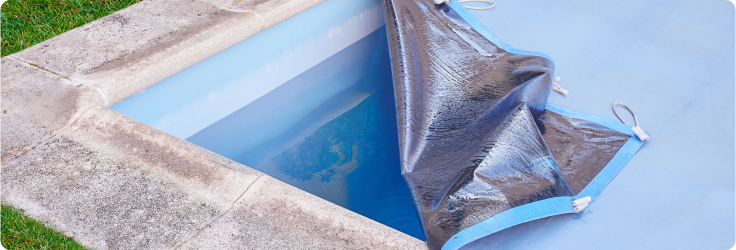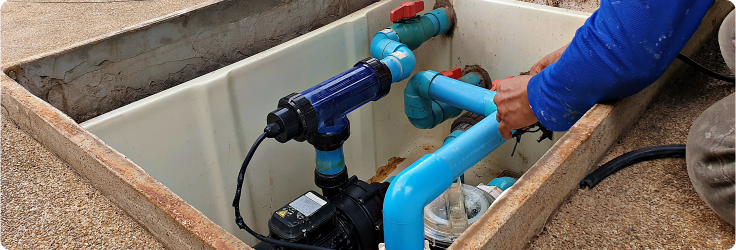Dive into worry-free coverage.
See how a protection plan can help cover pool and spa breakdowns.
Cannon-ball into outdoor pool season with a successful outdoor pool start-up.

The weather’s turning warm, and you’re ready to swim. But wait! Like every year, you’ve underestimated the number of steps in the pool start-up process.
While setting up your pool can at times feel so complex you need a chemistry degree for it, we’re here to walk you through every step of how to start up a pool. Follow along to get well on your way to crystal clear waters and fewer maintenance headaches, all season long.
If you’re interested in learning how to start up a pool, here’s the order in which you’ll typically proceed through the start-up routine:

It’s likely been a long time since you’ve last examined your pool. Time for the big reveal!

Before taking the next step in the pool start-up process, inspect the pump, filter, heater, and other pool equipment for cracks, leaks, or loose connections. Fix any issues before moving forward.

Over the off-season, your water level may have dropped— top it off to the recommended level before testing the chemistry. Using a reliable test kit or strips, check and adjust:
Each test kit is unique, so be sure to read the accompanying instructions carefully. If your water needs balancing, adjust it accordingly with pH increasers/decreasers, alkalinity boosters, or calcium hardness treatments. Finally, hit it with a shock treatment to kill off any lingering bacteria or algae. Chemistry can be one of the most difficult parts to master in learning how to start up a pool, but it’s essential for keeping your water clean, safe, and crystal clear.

Before anyone takes the first plunge, make sure all safety features are in place. Ladders and handrails should be secure, fencing and gates should be intact, and any pool alarms or covers should be in good working order.
While there are consistent strategies for swimming pool start-up, there are a few extra steps to add to the pool start-up process depending on which type you have:
Give the pool walls a gentle push— if they wobble, check for loose connections or rusting supports. Inspect the liner for wrinkles, tears, or signs of wear, and tighten any bolts or clamps holding the frame together.
Walk the perimeter and look for any settling or cracks in the deck or coping. Even small shifts in the ground can lead to costly repairs down the line, so if you spot any major changes, it may be worth consulting a pool pro.
Your salt generator is the heart of the system, so check for any buildup on the salt cells and give them a good cleaning if needed. Make sure the generator is working properly before adding any additional salt to the water— you don’t want to overshoot and end up with an ocean instead of a pool.
Vinyl: Inspect for tears, wrinkles, or bubbles. Even tiny rips can grow fast, so patch them ASAP.
Fiberglass: Look for cracks, discoloration, or chalky buildup— signs of wear that may require refinishing.
Concrete: If your surface is looking a little worse for wear, a quick pressure wash can remove stains and algae buildup. If you spot deep cracks, it may be time for resurfacing.
See how a protection plan can help cover pool and spa breakdowns.

You’ve done the hard work of the pool start-up process— now let’s keep it in tip-top shape all season!
Set aside a few minutes each week forthese simple tasks:
Your pump, filter, and heater work hard— don’t ignore them! Give them a quick periodic check. Listen for strange noises, look for drips or leaks, and make sure everything’s running as it should. Tighten any loose connections and lubricate o-rings as needed.
If you have a saltwater system, inspect the salt cell for buildup. Cleaning it every few months keeps chlorine levels stable and your water feeling silky smooth.
And don’t forget to regularly inspect plumbing lines for leaks and check wiring for wear or corrosion. Catching issues early can save you from costly repairs and mid-season breakdowns.
Safety first, fun always! Make sure ladders, railings, and diving boards are secure. If you have pool fencing or alarms, test them regularly. Safety equipment like life rings and shepherd’s hooks should be accessible and in good condition.
Sometimes, even with the best maintenance, things go awry. Here’s how to tackle some common pool problems:
Adjust the pH and chlorine levels, give the filter a good backwash, and let the pump run longer. If that doesn’t clear things up, try a pool clarifier to help tiny particles clump together for easier removal.
Hit algae hard with a shock treatment and brush the walls and floor to break up any clinging spores. Keep the filter running continuously until the water clears up.
Check the thermostat settings and clear out any debris around the heater vents. If it’s a gas heater, make sure the gas valve is open; for electric, check for tripped breakers or blown fuses.
Inspect visible plumbing and equipment. Look for damp areas or drips under pumps and filters. Food coloring near suspected leaks can help you spot the source without draining the pool.
A successful pool start-up and careful maintenance means more time swimming and less time stressing over repairs. Unfortunately, even after mastering how to start up a pool and keep it running smoothly, things can break down. That’s where an American Home Shield home warranty plan comes in handy.
With coverage for up to 23 of your home’s major systems and appliances, American Home Shield’s protection stretches all the way from the upstairs bathroom to the outdoor pool, thanks to the add-on pool and spa equipment coverage. Whether you’re experiencing an issue with your pool sweep motors or your circulation pump motors, our coverage helps keep your pool’s heating, pumping, and filtration systems running smoothly— no maintenance records required, no age restrictions.
Want to dive into worry-free pool ownership? Learn more about home warranties with pool coverage here.
AHS assumes no responsibility, and specifically disclaims all liability, for your use of any and all information contained herein.
Have a plan for your home when things don't go according to plan
Shop Home Warranties